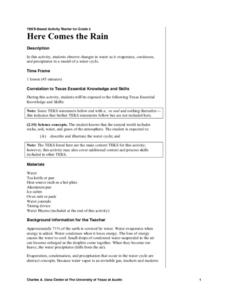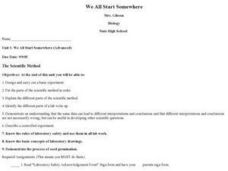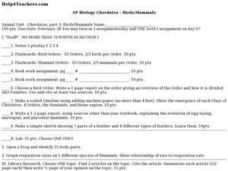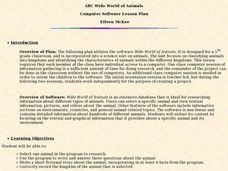Curated OER
Water Is Life
In this science activity, students color in the picture that portrays the environmental message about the role and necessity of water to support life.
Curated OER
Life Science Final Word Search Puzzle
In this literacy worksheet, middle schoolers find the words that are related to the concepts that are the theme of the word search. New vocabulary is the focus of the puzzle.
Curated OER
Ks 2 Science Words
For this science worksheet, students locate 50 science terms on a word search. The words are general science words and include words from life, physical, and earth sciences.
Curated OER
DNA Isolation
Students use scientific methods to investigate the concept of DNA. They observe the DNA of human cheek cells. This is done with the use of a lab experience. Students record their observations and reflect upon on how each organism is...
Curated OER
Planting A Garden On Campus
Students investigate the school campus area in order to plan the best spot for a class garden. They create a map of the school and research the different types of soil that exist in order to find the best spot. The class takes the...
Curated OER
Unearthing The Facts
Learners use agriculture related questions in order to build research skills. The questions are given and then they are expected to determine the best resource for finding the answers. The connection to the farmer is how they use...
Curated OER
Bacteria Change Earth's Atmosphere
Tenth graders organize information to explain how photosynthetic bacteria contributed to climatic changes that happened on Earth. Students create a timeline by using a storyboard to tell the story of the change.
Curated OER
More Lizard Snacks
First graders examine the development of worms at their various stages. They identify the worm and what stage it is in. Students practice observing the life cycle and documenting the changes.
Curated OER
Here Comes the Rain
Second graders help to prepare a model of the water cycle before the conduction of this experiment. They use the model in order to observe changes that happen to water when it changes states of matter.
Curated OER
Changing How Things Look
Third graders use a literature study in order to investigate how organisms effect an ecosystem. They are asked questions about change taken from the book. Students also take a nature walk to make field observations.
Curated OER
Sticky Tongue
Third graders make inquiry about the adaptations that help a frog to survive in its environment. They identify the adaptations and define how they work. They also research the idea of how species have common characteristics.
Curated OER
The Same But Different
Fourth graders observe different types of bats. They look for characteristics that appear to be fundamental for survival. Students observe population numbers in order to identify if adaptations aid in survival.
Curated OER
The Things We Do
Fourth graders conduct a literature study in order to investigate the concept of change and how it occurs in the environment. The teacher uses the method of concept development for investigation.
Curated OER
Come to Mommy
Fourth graders participate in a simple experiment to illustrate the concept of mother bats identifying their young. They sniff stickers in order to imitate the behavior of mother bats in the wild.
Curated OER
What's Happening to Our Caterpillars?
Seventh graders participate in a lesson making observations of caterpillars. They identify different changes in the life cycle of a caterpillar and also understand the final result of the life cycle ending.
Curated OER
Eeks Beaks
Seventh graders examine the concept of adaptations that take place in the wild. Birds are the focus organism for this study. They examine the beaks of different birds and point out the differentiations.
Curated OER
Hunting For Bats
Fourth graders investigate the adaptations that occur in bats. The benefits of adaptations are discussed with them and the probability of survival is measured. The specific adaptations are written and defined.
Curated OER
The Brown Pelican Experts
Fifth graders compare and contrast adaptations of brown pelicans and examine how they survive in different environments. They also make predictions of some adaptations that could be needed in certain types of ecosystems.
Curated OER
What's That? Diversity Among Organisms
Seventh graders can go outside and explore the organisms that live in the environment outside their door. This is a wonderful opportunity for students to examine the world around them with a new perspective. This activity will increase...
Curated OER
We All Start Somewhere
Students demonstrate an understanding that the same data can lead to different interpretations and conclusions and that different interpretations and conclusions are not necessarily wrong, but can be useful in developing other scientific...
Curated OER
AP Biology Chordates - Birds/Mammals
Learners participate in a layered curriculum units with a variety of activities like: Library Research and choose one topic. Find 2 articles on the topic, cite the article, and summarize each article.
Curated OER
Where Do Green Plants Get Energy?
Fourth graders realize that plants need light, water, and carbon dioxide to carry out photosynthesis. They participate in groups of 4 to plant (with materials provided) a test group of beans to compare to the control group, write a...
Curated OER
ABC Wide World of Animals
Fifth graders use the software Wide World of Animals. This lesson is incorporated into a science unit on animals. The unit focuses on classifying animals into kingdoms and identifying the characteristics of animals within the different...
Curated OER
Save The Forest
Students summarize their role as a (particular) specialist. They select items needed for their research in the rainforest. Students explain the problems that their team is faced with and describe how the two assignments relate to botany.

























